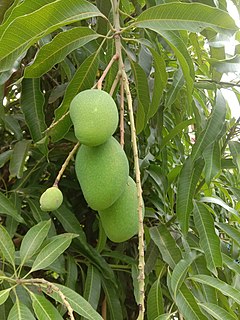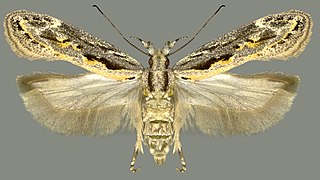
Azadirachta indica, commonly known as neem, nimtree or Indian lilac, is a tree in the mahogany family Meliaceae. It is one of two species in the genus Azadirachta, and is native to the Indian subcontinent and most of the countries in Africa. It is typically grown in tropical and semi-tropical regions. Neem trees also grow on islands in southern Iran. Its fruits and seeds are the source of neem oil.

Tamarind is a leguminous tree bearing edible fruit that is probably indigenous to tropical Africa. The genus Tamarindus is monotypic, meaning that it contains only this species. It belongs to the family Fabaceae.

The genus Tamarix is composed of about 50–60 species of flowering plants in the family Tamaricaceae, native to drier areas of Eurasia and Africa. The generic name originated in Latin and may refer to the Tamaris River in Hispania Tarraconensis (Spain).

Cannabis indica is an annual plant species in the family Cannabaceae which produces large amounts of tetrahydrocannabinol (THC) and is cultivated for purposes including hashish in India. The high concentrations of THC provide euphoric effects making it popular for use both as a recreational drug, alternative medicine, and a clinical research drug.

Kasur District, is a district located in Lahore Division of Punjab, Pakistan. It came into existence on 1 July 1976. Prior to its creation, it was a tehsil of the Lahore District.

Tamarix aphylla is the largest known species of Tamarix, with heights up to 18 metres (59 ft). The species has a variety of common names, including Athel tamarisk, Athel tree, and Athel pine. It is an evergreen tree, native across North, East, and Central Africa, through the Middle East, and into parts of Western and Southern Asia.

Mangifera indica, commonly known as mango, is a species of flowering plant in the family Anacardiaceae. It is a large fruit tree, capable of growing to a height of 30 metres. There are two distinct genetic populations in modern mangoes – the "Indian type" and the "Southeast Asian type".

Tamarix ramosissima, commonly known as saltcedarsalt cedar, or tamarisk, is a deciduous arching shrub with reddish stems, feathery, pale green foliage, and characteristic small pink flowers.

Tamarix gallica, the French tamarisk, is a deciduous, herbaceous, twiggy shrub or small tree reaching up to about 5 meters high.

Tamarix chinensis is a species of tamarisk known by the common names five-stamen tamarisk and Chinese tamarisk or saltcedar. It is native to China and Korea, and it is known in many other parts of the world as an introduced species and sometimes an invasive noxious weed. It easily inhabits moist habitat with saline soils. It may grow as a tree with a single trunk or as a shrub with several spreading erect branches reaching 6 metres or more in maximum height. It has been known to reach 12 metres. It has reddish, brown, or black bark. The small, multibranched twigs are covered in small lance-shaped, scale-like leaves which are no more than about 3 mm long. The inflorescence is a dense raceme of flowers a few cm long. Each fragrant flower has five petals which are usually pink but range from white to red.
Agdistis tamaricis is a moth of the family Pterophoridae found in Africa, Asia and Europe. It was first described by the German entomologist, Philipp Christoph Zeller in 1847.
Ascalenia pachnodes is a moth in the family Cosmopterigidae. It has been recorded from Nubia and India (Bengal).

Ornativalva plutelliformis is a moth of the family Gelechiidae. It was described by Staudinger in 1859. It is found from southern Europe and North Africa east to western Asia and China (Xinjiang).
Amblypalpis olivierella, the tamarix spindle-gall moth, is a species of moth in the family Gelechiidae. It was described by Émile Louis Ragonot in 1886. It is found in Tunisia, Algeria, Libya, the Sinai, Egypt, Israel, Jordan, northern Yemen and the United Arab Emirates, Iran, India and Pakistan.

Tamarix nilotica, the Nile tamarisk is a species of shrub or small tree in the tamarisk family. It is found in arid parts of North Africa and the Middle East, particularly areas with high salinity. It forms part of the dune stabilisation process.

Tamarix dioica is a twiggy shrub or small tree that grows in saline habitats in western Asia. Common names include ghaz and khagal in Pakistan, lal jhau, urusia, ban jhau, nona-gach, urichiya in Bangladesh and nona jhau in the Sunderbans.

Mihrabat Nature Park is a nature park located on the Asian part in Beykoz district of Istanbul Province, Turkey.
Sphrageidus xanthorrhoea is a moth of the family Erebidae first described by Vincenz Kollar in 1848. It is found in India, Sri Lanka, Java and Indonesia. It was once classified under the genus Euproctis, where it is accepted by some authors.













